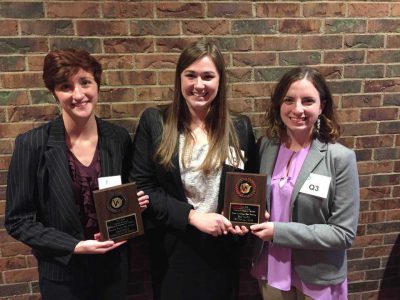Second-year DVM student Rachel Baumgardner shares her experience as a part of the Animal Welfare Team. She earned first place in the individual veterinary student division at this year’s Intercollegiate Animal Welfare and Assessment Judging Contest in Columbus, Ohio.
Veterinary school is a lot of work. And I don’t mean physical work–well, unless you count the unending flights of stairs. I mean mental work. I spend most of my time during the semester either in lecture, studying lecture, or researching topics that I didn’t understand in lecture. The rest of the time, if I’m lucky, involves socializing, eating, and sleeping—sometimes all at once.
However, many of us veterinary students also devote time to extracurricular clubs and activities. “Why?” you might ask. Well, a lot of us are considered “go-getters,” or “Type-A,” or “clinically insane.” This means that in addition to school, we find a topic that we are passionate about and go the extra mile for it. For some, it’s emergency medicine. For others, it’s large animal palpation. For me, it’s animal welfare.
I started working with the Animal Welfare Judging Team during my first year of veterinary school. My teammates and I were eager to learn about the different species at the annual competition; however, we didn’t quite realize the amount of work we’d have to put in. Each species is incredibly different, from elephants to guinea pigs, and each species comes with different welfare concerns. For example, guinea pigs prefer regular schedules and need vitamin C in their diets to live healthily. Did you know that llamas need to be handled differently than other farm animals to avoid severely injuring their necks or noses? I didn’t know until I joined the Animal Welfare Judging Team! We spent hours researching scientific studies on animal behavior and welfare issues, as well as talking to experts in the field and learning from them.

The competition itself is your chance to stand on a soapbox–and be critiqued for it. We all know that ranting about a topic we feel strongly about, from politics to movies, feels great. Based on my social media feeds, I would say that many enjoy vocalizing their opinions. The Animal Welfare Judging and Assessment Contest, put on by the American Veterinary Medical Association, is a chance to make informed opinions and arguments for animal welfare. It involves studying facts about the species, hearing expert opinions and stories, and making quick and concise arguments for or against certain practices. Often, the scenarios presented to us are two different farms, zoos, pet living situations, or animal laboratories that compare methods of animal handling, nutrition, medical care, training, and many others.
That’s the beauty of animal welfare. It isn’t laser-focused on one discipline. Animal welfare is the specialty of seeing the big picture. It forces you to focus on what’s important overall because no situation is perfect. No farm is going to have everything right, and no zoo is going to have the best for each animal. But as a future veterinarian, it’s important that I encourage people that work with animals to improve. We can raise the amount of milk a cow produces, but we can also make sure she’s comfortable walking around in the barn and that she’s kept clean so she stays healthy. Animal welfare is a balancing act between what is economically feasible and what is best for the animal.
It’s important to distinguish animal welfare from animal rights activism. The best way that I’ve heard it described is that animal rights is treating animals like they are humans, and animal welfare is treating animals like they are living things. Although some might think that all chickens would be happier outdoors, many realize that they would be susceptible to parasites and predation this way. I have learned a lot by practicing informed decision making and concise debate through the Animal Welfare Judging Team, and I hope to bring those skills with me as I work toward my DVM and beyond.
